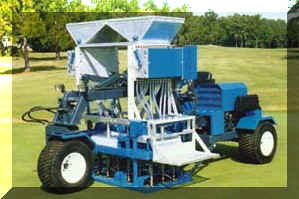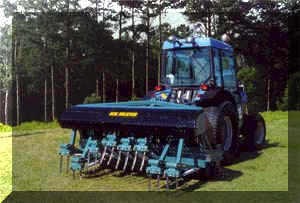256-255-5231
Deep Aerification Specialists
256-255-5231

![]()
University of Georgia turfgrass researcher, Dr. Bob Carrow (USGA Green Section Record, March-April 2003)
"The number-one problem experienced on sand-based putting greens is the excessive accumulation of organic matter in the upper portion of the soil profile. Core aeration and sand topdressing are the two most effective means to control the content and distribution of organic matter in this zone."
"The decrease of macropores (aeration pores) is accompanied by an increase in capillary or water-holding pores. Core aeration and applying sand can help dilute organic accumulation and create new macropores."
"If organic matter accumulation begins to exceed 3-4% by weight, putting greens become vulnerable to a host of secondary problems such as disease, wet wilt, soft surfaces, poor root growth, black layer, and more frequent high-temperature injury."
Bert McCarty, Ph.D., and Alejandro Canegallo (Golf Course Management, June 2005)
"Frequent hollow and solid tine aerification opens the soil to the atmosphere, allowing rapid exchange of soil air with ambient air and purging carbon dioxide, hydrogen sulfide and methane."
"Aerify 15%-25% of the surface area each year by manipulating the diameter of coring tine used, tine spacing and the number of aerifications."
"At least one annual deep-tine (6-10 inches deep) core-aerification will help relieve the subsurface soil compaction that naturally develops with greens."
On Localized Dry Spot ..... "Use penetrating forks or solid tine aerification on dry spots to facilitate water penetration"
Will Wolverton (Superintendent Magazine, May 2005)
"... Most aeration machines work at a level of about 3 to 4 inches, whereas compaction is quite often found in the deeper layers of the soil. Shallow aeration may cause a layer of compaction, which is sometimes referred to as a black layer. At this black layer, roots (as well as water, air and nutrients) cannot extend any deeper into the soil. This is why a program of using shallow and deep aeration is desired."
"You will find that one major advantage of the latest deep tine machines is the ability to change the angle of entry that increases the amount of soil displacement at the maximum depth."
"Coring tines offer some elimination of thatch, along with a reduction in soil compaction, and are a good tool for exchanging soil profiles over a period of time. Solid tines do a good job of fracturing the soil, especially when you can adjust the angle of entry and eliminate the mess of cleaning up the cores."
"A good suggestion is to use a mixed bag of tine types and sizes that will create proper air, water and nutrient exchange. By being able to vary the depth of aerification easily, you can avoid layering and allow for deep root penetration."
University of Florida, J.B. Sartain, H.D. Gooding, R.H. Snyder and T.W. Shaddox (Florida Turf Digest, May/June 2005)
"The inclusion of 15% Fe-Humate, Profile and PSA in the root zone mix significantly enhanced water-use efficiency and the growth of Tifdwarf bermudagrass."
"After a green is established, the only way to incorporate amendments (short of completely reworking the green) is to include the amendments in a topdressing mix following aerification."
Cornell University Associate Professor of Turfgrass Science, Frank S. Rossi (Golfweek's SuperNews, August 2004)
"Research by Carrow (Dr. Bob Carrow, University of Georgia) indicates that coring followed by large amounts of sand will reduce organic matter levels by 2 percent over three years."
TurfNet General Manager/Editor, Peter L. McCormick (Golfweek's SuperNews, August 2004)
"Traditional core aeration does little to alleviate subsurface compaction below the depth of tine penetration or between the core spacing. This has led to the popularity of deep tine aerators such as the Verti-Drain and the Soil Reliever to penetrate below the usual cultivation layer with a pitchfork action."
![]()
Southeast Turf Maintenance
211 Skyline Road Madison, AL 35758
Phone: 256-255-5231 Email: seturfmaint@gmail.com


